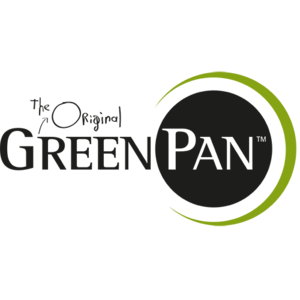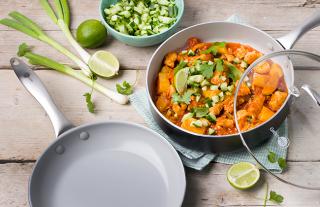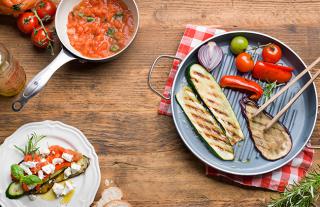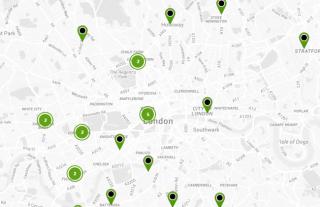You are here
Yes! But it is always good to note that the handle and body material determine what is oven safe. It is always best to check the packaging for the exact temperature your cookware can withstand. Please read carefully.
- Stainless steel handle? Oven safe up to any temperature you like without worry!
- Stainless steel handle with a silicone insert (soft, rubber part of the handle): Oven-safe up to 428°F.
- Bakelite handle (mostly black, plastic like): Oven-safe up to 356°F.
- Lids: Stainless steel can be used up to any temperature but glass lids are oven safe up to 390°F if all the fitting are stainless steel. However if the lid has any Bakelite elements then it is oven safe up to 356°F
When in doubt, check the packaging!
- Do not preheat the frypan for too long. Remember that the ceramic non-stick coating doesn’t block the heat like traditional non-stick coatings do, so you will achieve the correct heat faster.
- Put some butter or oil in the pan shortly after placing it on the stove. That way the pan will not boil dry, which would cause it to overheat very quickly.
- Get to know your pan! During your first few cooking sessions, use it on low to medium heat. Soon you will learn how the pan behaves on your hob and can proceed from there.
- Avoid your butter getting too brown or your oil smoking. If this happens, we recommend throwing away the fats and starting over on a lower heat setting.
- Keep your food in motion by stirring or turning it regularly. This motion cools the pan and the oils down so they don’t overheat. This also enhances evenly cooked food. Did you know that a steak that is turned every 15 seconds is fried more evenly?
- Choose a pan that fits the size of your food but isn’t too big. When using a pan that is too big, the empty spots will overheat quickly and cause the fat to burn and carbonize there.
Short answer: No! Long answer: Seasoning was a technique to create a non-stick layer in an uncoated pan, usually cast iron. This technique is absolutely not recommended on a non-stick frypan as it would instead of helping, would damage the ceramic non-stick coating. When the seasoning layer would be heated on the stove top, it would start forming a carbonised layer and damaging the non-stick performance.
Instead, always make sure to start with a clean and degreased pan and use a tiny bit of oil or butter when heating.
- Oil conducts heat much better than air resulting in better and crispier frying
- Oil acts as a buffer so food doesn’t burn that quickly
- Oil helps in browning food and the development of taste (so called Maillard reaction: Google it!)
- Oil avoids food sticking to the pan. Even liquid food like eggs do need a little oil or butter! A non-stick pan, like our GreenPan, allows the use of less oil, but not completely eliminating it because of above reasons.
We recommend using butter or (preferably organic) oils suited for frying with high resistance. Peanut oil, coconut oil or sunflower oil are good oils to start with.
Unrefined oils, like Extra Virgin Olive Oil, as healthy as they are, are not suited for frying because they can start smoking and burning at relatively low temperatures. Not only is this not good for your health, it’s not good for your pan. It can create a layer of carbonisation on your non-stick coating resulting in the loss of non-stick performance.
We don't recommend using oil sprays, including aerosols, mist, and pump sprays. Small spray droplets heat up very rapidly and carbonise easily on the non-stick surface. This will leave a layer on the coating and will affect the non-stick performance of the pan.
Technically you can fry in a GreenPan without oil, but we don’t recommend it. As described above, using oils has multiple advantages which increase the quality and frying results of your food. When considering removing oils for health reasons, know that choosing the right oils actually bring important nutrition to your diet.
Cleaning your GreenPan is a breeze!
- Allow the pan to cool completely to avoid thermal shock and deforming
- Wash the pan in warm water and clean with a soft sponge or cloth. Avoid abrasive pads or steel wool.
- Dry with a soft towel and you are done!
Some ranges are dishwasher safe, but we recommend handwashing. Wash with a little soapy water and clean it with a soft dishcloth or sponge. The non-stick properties of all ceramic non-stick coatings slowly fade with repeated dishwasher use because of the aggressive detergents in dishwasher soap.
Brown stains are usually carbonised oils or fats that have burned onto the non-stick coating, caused by overheating them. As you’ll see, they are not easily cleaned off by traditional hand washing or dish washing and they tend to build up over each use, burning more and more. This layer prevents contact of food with the non-stick coating, causing food to stick to the pan.
We recommend to remove even the earliest of traces of carbonisation (even before they are brown) with a Melamine sponge and plain water. It pays off to inspect the pan after drying it to spot these early traces. The sooner you are able to remove them the less damage they can do to the non-stick.
If you cannot remove them with the melamine sponge and water, try replacing water with vegetable oil. Internal tests show that this works slightly better with heavy carbonisation.
NOTE: do not use a melamine sponge for daily cleaning of the non-stick coating, as it is slightly abrasive and would damage the non-stick performance over a prolonged period of time
Our cookware is designed in our Belgian offices by our in-house product designers. It is produced, tested and manufactured in our own factory in Jiangmen, China. As we own the factory, which has been awarded multilple ISO awards, we also have full control of the quality of the products we deliver.






